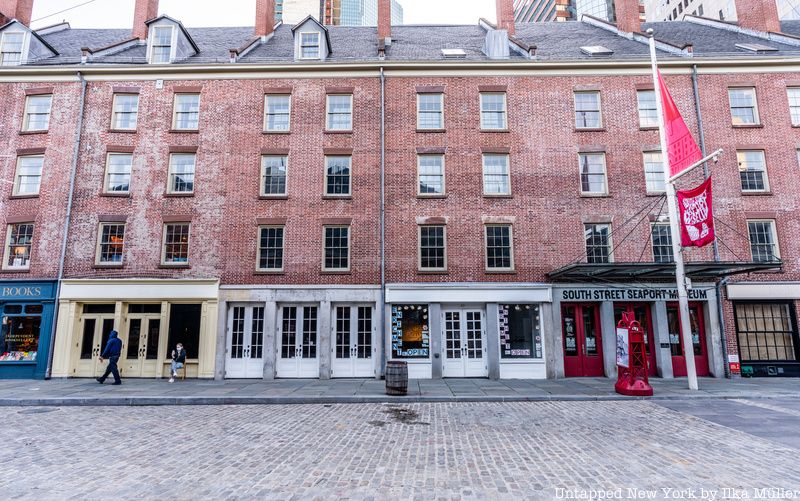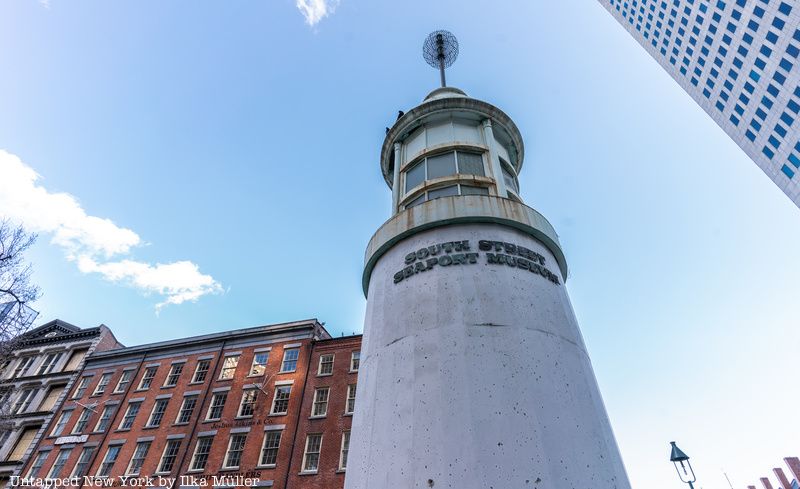Last-Minute NYC Holiday Gift Guide 🎁
We’ve created a holiday gift guide with presents for the intrepid New Yorker that should arrive just in time—


This article is written by William Roka, a historian with the South Street Seaport Museum.
Titanic and New York City, the world’s greatest ship and the world’s greatest port, were meant to come together, although the two would never meet. Titanic was built in Belfast for the White Star Line, which was headquartered in Liverpool, and she sailed on her maiden voyage from Southampton. The sinking of Titanic sent shockwaves through New York high society, intimately linking the superliner and the metropolis.
Even if Titanic had avoided her fateful meeting with the iceberg on April 14, 1912, she would have only held the title as the world’s largest ship for a short time. The German steamship company Hamburg-America Line launched their significantly larger Imperator a mere month after the sinking of the Titanic. Titanic was a member of an exclusive club of new giant luxury liners being built with a focus on size and opulence.
While steamship companies made the majority of their profits from the carriage of migrants, these new superliners were being built specifically to cater to wealthy Americans, who made up 80 percent of the first-class passengers traveling between Europe and the United States. These superliners dedicated up to two-thirds of the ship’s space to the needs of first-class. Nicknamed the “millionaires” ship by some, Titanic was crossing the Atlantic in April 1912 on her way to the city of millionaires, New York.

Illustration from the South Street Seaport Museum collection
By 1912 New York was the world’s busiest port and home to many of the wealthiest people in the world, including the wealthiest passenger aboard Titanic, John Jacob Astor IV. Astor was the type of person for which Titanic and her fellow superliners were built to serve. The fortunes behind many prestigious names, none more so than Astor, originated in the part of New York that had made New York into a global metropolis, the South Street Seaport.
John Jacob Astor IV was worth an estimated $90 million dollars in 1912 ($12.7 billion in 2015), and he only represented one of several branches of the Astor family. The majority of Astor’s wealth was from real estate, which included several well renowned New York hotels. However, the foundation of the entire Astor family’s wealth rested on the fortune created by one man, the original John Jacob Astor. It was along South Street and the shores of the East River where the first Astor began his ascent to become the richest man in America.
Astor I, the son of a butcher, emigrated to the United States from Germany, via Great Britain, in 1783. Peddling musical instruments and baked goods in his first few months in New York, Astor eventually landed a job with the Pearl Street based printing firm Bowne and Company, the namesake of today’s South Street Seaport Museum’s Bowne and Co. Stationers. His time at Bowne taught Astor much about trade and business, most especially about the fur trade, which Bowne had as a side business.
Astor eventually left Bowne to set up his own business in the fur trade, establishing himself on Water Street. As his business grew Astor invested more of his income in purchasing New York real estate. Astor’s business ventures in the following decades expanded into the fur trade in the Pacific Northwest and in the China Trade. When Astor died in 1847, the butcher’s son was the wealthiest man in America worth $20 million ($9.7 billion in 2015 dollars).

Astor I was not the only great-grandfather that connected John Jacob Astor IV to South Street. Astor IV’s mother, Caroline Schermerhorn Astor, was descended from one of New York’s oldest and most respected families. Caroline’s grandfather Peter Schermerhorn was a merchant trader and like his contemporary, the original John Jacob Astor, invested heavily in real estate. The largest real estate project that Peter Schermerhorn invested in was a massive building project completed a century before the Titanic disaster, Schermerhorn Row.
Today Schermerhorn Row, located on Fulton Street, is the core of the South Street Seaport Museum. Completed in 1812, Schermerhorn Row was originally a set of Federal style brick counting-houses that used an innovative design of combining a merchant’s office, warehouse, and store into a single structure; and all conveniently located close to the city’s then bustling main port. Caroline’s father Abraham expanded Peter’s trade and real estate interests. In 1853 Caroline married William Backhouse Astor, Jr., linking one of New York’s most prominent families to one of its wealthiest. Caroline would spend the next several decades trying to transform New York’s high society into an American aristocracy.

Caroline’s son, John Jacob Astor IV, lived life among his family’s many mansions. Astor served during the 1898 Spanish-American War, wrote science fiction stories, and was an inventor. Then in 1911 Astor shocked New York society. After divorcing his first wife he married Madeline Force, a girl of 18 and nearly 30 years his junior. John Jacob Astor IV and Force fled to Europe to escape gossip and decided to winter in Egypt. Having spent several months abroad Astor felt it was time to come home as Madeline was now pregnant. The newlyweds boarded Titanic at Cherbourg, France. Even though Astor’s wealth helped him escape scandal and gossip, it would do him little good on the night of April 14, 1912.
After Titanic struck the iceberg and as the lifeboats were being lowered, many not filled to capacity, Astor still thought that remaining on Titanic was the safer option. Then reality finally set in as people realized the giant liner was actually sinking and that no one was coming to the rescue. Astor was able to get Madeline onto a lifeboat, but he would be among the more than 1,500 people who perished.

Unlike so many of the other people who went down with Titanic, Astor’s body was one of the 334 recovered. Most of the bodies recovered only had their meager clothes and the life vest on them. Astor, however, was found with a gold watch, gold cufflinks, a diamond ring, several thousand dollars in cash, gold and silver coins, and even a gold pencil. Astor’s fortune was a New York fortune, a fortune, like many on the Titanic, born at the South Street Seaport. The names Harper, Gracie, and Roebling were also among Titanic’s first-class with links to South Street. The Titanic was built primarily to serve wealthy Americans, but as Titanic sank to the bottom of the sea the icy waters of the North Atlantic did not distinguish between rich and poor that April night in 1912.
Next, check out 6 famous shipwrecks in New York City and 10 Secrets of the South Street Seaport
Subscribe to our newsletter